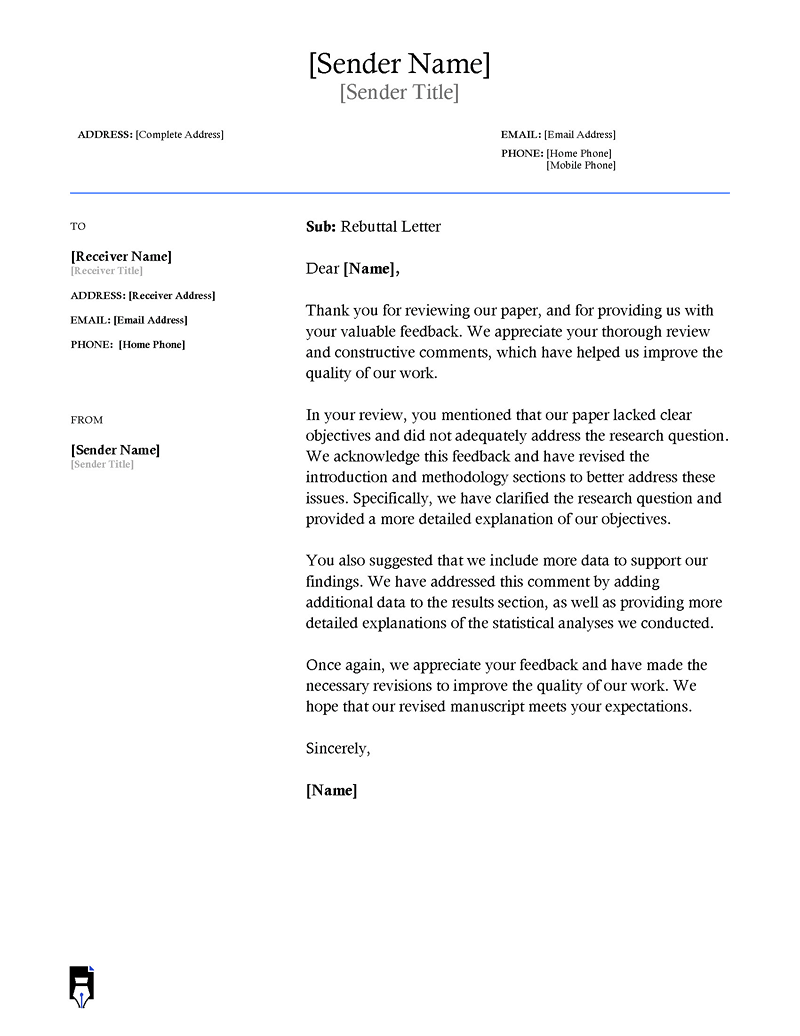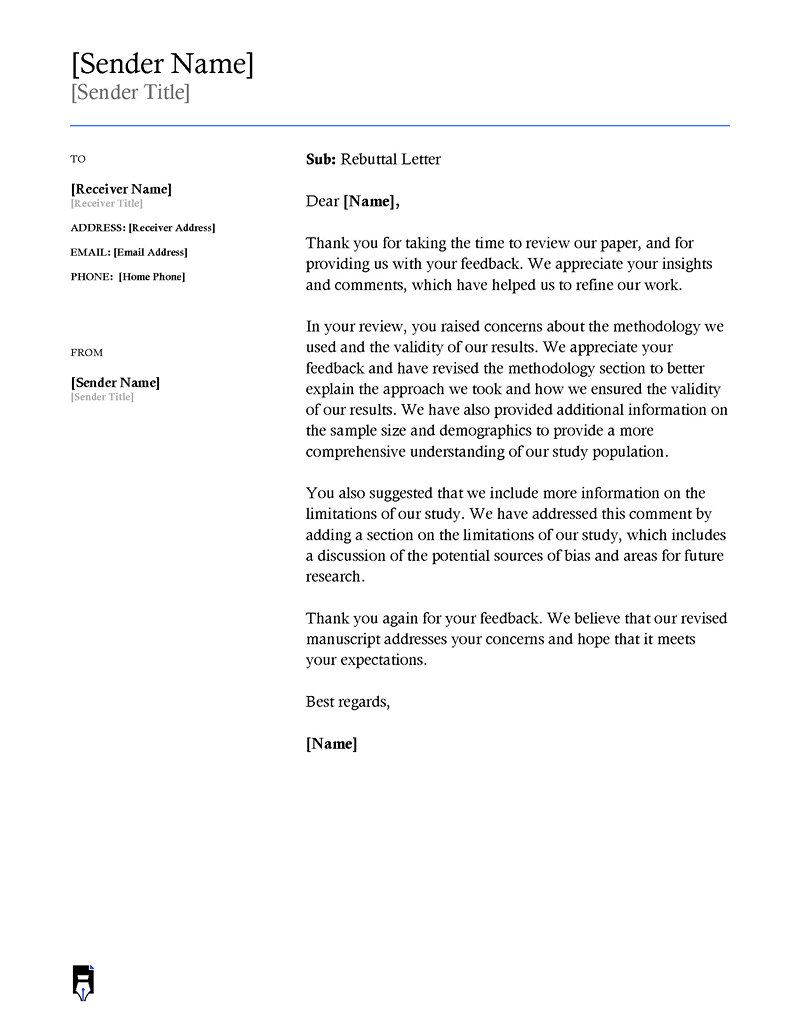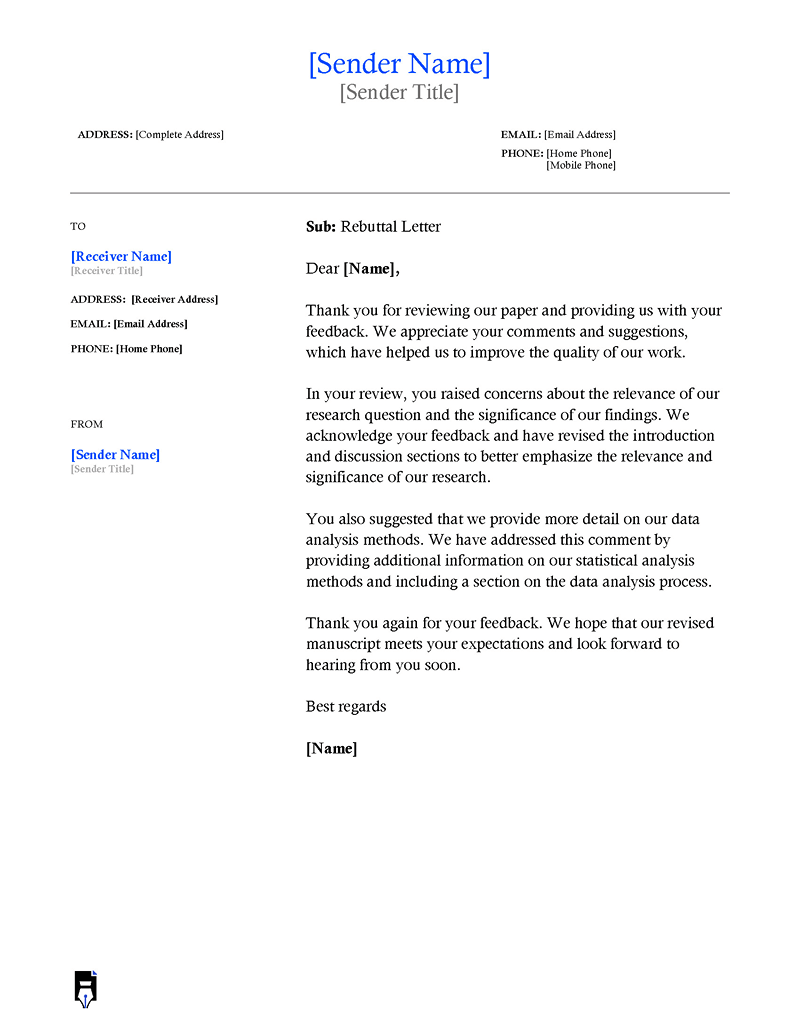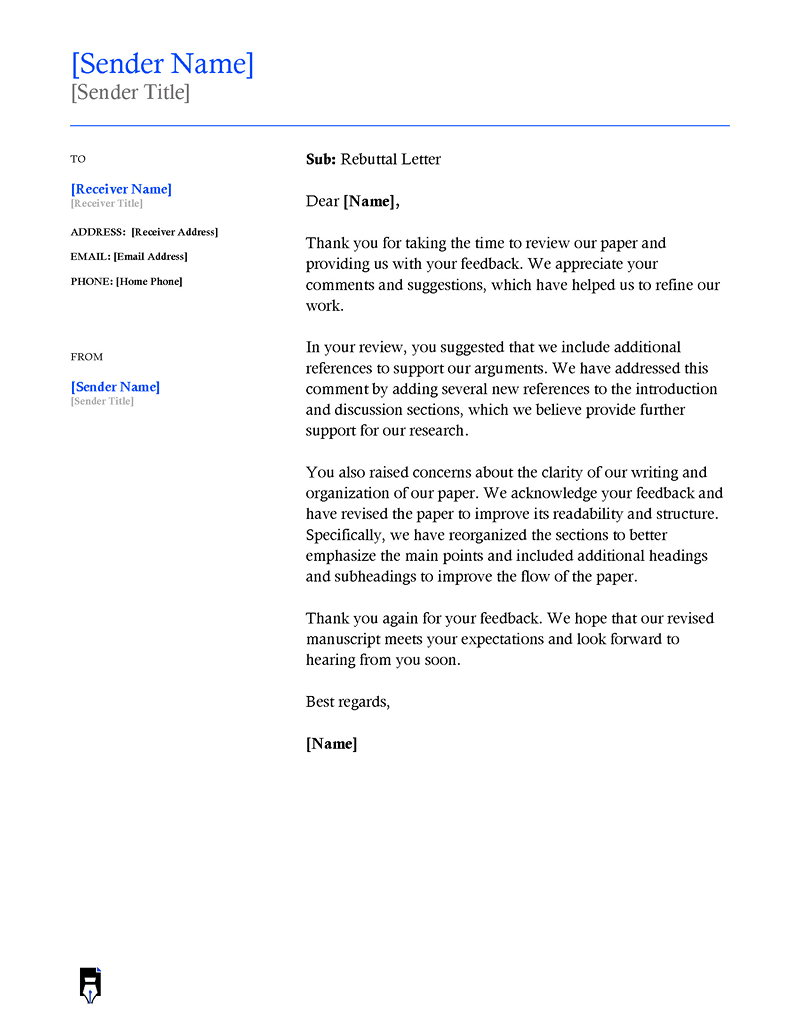The journal rebuttal response is written by the author of a manuscript when they receive feedback from the editors or reviewers of a scientific journal about their work. The editors or reviewers explain why the article cannot be immediately published and how the manuscript must be revised to be acceptable for publication.
A rebuttal letter allows the author to respond to the comments while also convincing the editors and reviewers of the importance of their research, how they will incorporate the suggestions, and, if necessary, defend the article.
The letter is usually submitted alongside the revisions made to the manuscript. This letter increases the chances of a manuscript being accepted by a journal.
What is a Rebuttal Letter?
A rebuttal letter is an official document that allows an author to respond to comments from reviewers while informing them of how they intend to improve their work.
With this letter, an author can address any misunderstandings and concerns regarding their paper.
Understanding how to write a good letter is an essential step in effectively responding to the feedback from reviewers. Moreover, an author can use it to defend their work or aspects of it. Whether an author receives requests for minor or major revisions, the tone they use in the letter should be confident. The idea is to inform the reviewers that the paper contains all the information they want without sounding arrogant or rude.
Authors are generally given 3-6 weeks to resubmit the manuscript with the required revisions.
Regarding formatting, authors or researchers should highlight all the corrections, mark deletions using strikethroughs, use the red color for the changes, and allow the Track Changes option while using MS Word.
Rebuttal Letter Templates
Did you Know? Journal rejections are common, irrespective of the researcher’s academic career and institutional affiliation. The scientific disciplines differ significantly from one another, with biomedicine having a higher acceptance rate than, say, the social sciences (Enago Academy). Subscription journals typically have lower acceptance rates than open-access journals. Overall, the rejection rate among top-tier journals is usually 90–95% (SpringerLink). Therefore, it is not uncommon to approach journals after a manuscript has been refused publication.
How to Write a Rebuttal Letter
A rebuttal is an official communication with a research journal and thus should be written professionally and convey your response effectively. The contents, style, and structure of this letter are all important and follow a standard format.
Here’s how to write a proper, detailed letter:
Write a polite header
Since this document is a business letter, start with a polite header and salutation. Ensure that you include the date, the journal’s name, and the name of the editor. Based on their title, you should refer to them as Dr. or Professor, plus their name. It is not advisable to use Mr., Ms., or Mrs. unless they used it when they sent you the feedback. Also, include the title and reference number of the manuscript to make it easier for the editor to identify the document.
For example:
Dr. Philip Matthews
Editor-In-Chief
The Urban Journal of XYZ
January 11, 2022
Dear Dr. Matthews,
Express thanks
After the header, thank the reviewers for their feedback. Whether or not you agree with their comments, ensure that you thank them officially in the letter.
For example:
We would like to express our gratitude for reviewing our manuscript and providing your feedback. We are grateful for the help, as the comments will help us improve our work.
Give point-by-point responses
When responding to the reviewers’ comments, ensure that you provide point-by-point responses. Always number the reviewers’ comments and respond to them one after another. Your responses should be respectful and formal, without harsh remarks. Also, thank the reviewers for their feedback before responding, and avoid correcting any of their spelling or grammar mistakes. Instead, focus on avoiding any grammar and spelling mistakes in your writing, as those will make your response look unprofessional.
For your point-by-point responses, it is advisable to be thorough rather than brief. Furthermore, you can use the first-person or third-person voice for your responses, but you should remain consistent. Also, it is advisable to use gender-neutral pronouns unless you know the reviewer’s identity.
For example:
As indicated in the document, here are the revisions we have made to improve the manuscript.
Reviewer 1: Ensure that you include more references and citations.
Thank you, worthy reviewer, for your comment. We have added proper citations throughout the document. Particularly in our methodology chapter, many relevant in-text citations have been added to improve the credibility of our research methods.
Categorize reviewers’ comments
In case you have received many comments, it is best to categorize them before responding. You can separate them by language, methodology, or any other criteria that will help you address the reviewers’ comments in a more organized way.
You can also choose to categorize the comments into major and minor ones.
Major comments address the content of the manuscript, such as the research methodology, sample size, inadequate literature review, lack of relevance, etc., while minor comments are related to errors in data presentation, table formatting, or even syntax mistakes. Ensure that you inform the editor how you have categorized your responses.
For example:
Since we have received many different comments on our manuscript, we have divided them into five categories to easily and efficiently address each comment. Each category has been labeled, which will help you easily identify our responses to the comments.
Category 1: Punctuation and Spelling Mistakes
We noted the mistakes we had made in regard to punctuation, grammar, and spelling. English is not our first language, which has therefore led to these mistakes. We have taken the time to correct all these mistakes. A native speaker has also reviewed our work. We have carefully highlighted these changes.
Tip: It is advisable to split the text into bullet points for clarity. If you require clarity or further explanation on any comment, ensure that you inform the reviewer about it and then include your response on what you understand.
Clarify the misunderstood points politely
If you feel like a reviewer has misunderstood a certain aspect of your work, you can clarify the issue politely. It can be that the reviewer is not an expert in that particular field or that you were not clear in your presentation; ensure that you properly clarify the issue and mention the revision in your letter.
For example:
Reviewer 2: There is a need to include more charts and graphs for data representation.
We appreciate the worthy reviewer’s comment. However, we would like to correct any misunderstanding that may have occurred. This work is a review article and thus does not contain any original research conducted by us. We plan to expand on our work and provide extensive data in the next stage of our research.
Provide a reason if you have not addressed any point
Sometimes, there can be some suggestions that you do not consider to be relevant to your article. However, it would be best to not entirely ignore the suggestion. Pay close attention to the comment and try to include it, even if partially.
In other cases, you might choose not to address the reviewers’ comments. If this is the case, ensure that you provide a reason for this decision. Be polite, positive, and objective with your reasons. Also, make your response clear and logical, including supporting evidence. Avoid giving personal reasons.
For example:
Reviewer 2: When dividing the countries into groups, the authors have excluded countries like Greece, Italy, and Belgium, which have a very high debt-to-GDP ratio. It would be useful to include them as well.
When dividing the countries into groups, our criteria have been more related to the steps of the formation of the EU. Consequently, we have not added any alternative classifications. Perhaps this approach could be used in future studies.
Mention the location of the figures
Finally, ensure that you accurately reference the location of any new information you have included in your manuscript, such as figures, data, and tables. The page numbers of the sections that have been revised should be mentioned.
For example:
We have indicated all the changes in red. You will also find new figures on pages 2, 3, and 4. We have included new tables to represent the data on pages 9, 11, and 12.
End the letter with a positive note
In the conclusion of your response letter, remain positive and respectful. Be straightforward about hoping that your manuscript will be accepted, but remain polite. Being overly confident about your revisions or using a rude tone is not appropriate. Show that you have not only revised the work correctly but that you are also willing to make any additional revisions. It is also important to provide your full contact details and those of the corresponding author(s).
For example:
We would like to thank you once again for your insightful suggestions. We have addressed all the comments to the best of our abilities. We have revised the manuscript in light of the reviewers’ comments and hope that our manuscript will be accepted by your esteemed journal. We are available for any further questions and revisions. Thank you so much.
Sincerely,
Eunice Peters
765, Uphill University
Author
Ritah Evans
765, Uphill University
Corresponding Author
Rebuttal Letter Sample
Professor Samuel Richards
Editor-In-Chief
The United Journal of ABC
January 11, 2022
RE: Re-submission of Highland Manuscript (Reference no. RMJ-030609)
Dear Prof. Richards,
Please find the revised version of our manuscript titled “XYZ”, Reference no. RMJ-030609, attached to this letter. In order for our manuscript to stand a chance of qualifying for the United Journal of ABC, we have thoroughly revised it and addressed all the issues that were mentioned. We would like to thank you for reviewing our work and providing insightful feedback that has helped improve the quality of our manuscript.
For the revisions, we have addressed them as follows:
1) There is a need to modify the literature review section. The study of health among the poor is subjective and lacks enough references.
Response: Thank you for the comment. We appreciate your feedback, and we agree with you. The literature review for the section “health of the poor” needs more supporting evidence. We made changes, which are highlighted in red. The information has been added to pages 5 and 7.
2) Under methodology: Why did you focus on structure Q instead of Z
Response: Thank you for the suggestion. We focused on structure Z instead of structure Q because it helped us gather the data we needed for the research. We have explained the usefulness of structure Z in Figure 3 (page 10), where you will notice that this particular structure was more suitable for our research.
3) There is a need to conduct additional research on the Arena issue.
Response: We appreciate the comment. However, conducting additional research on Arena is beyond the scope of our research. The focus of our research has been to investigate the linkages between A and C only. The Arena is a related concept to our research but not relevant for the linkages we are investigating.
Apart from incorporating these major suggestions, we have also addressed all the minor ones by correcting the spelling or grammar mistakes and adding the required figures and tables to represent the data. We hope that all the changes we have made are sufficient for our manuscript to be published in the United Journal of ABC. We are available for any questions or further revisions. Thank you so much.
Sincerely,
Abigail Rose
123, Eden University
Author
Steven Philips
123, Eden University
Corresponding author
Pitfalls to Avoid
When writing your rebuttal letter, there are pitfalls that you need to avoid to ensure that your letter is effective and appropriate.
The following are some key points to remember:
Insulting reviewers
It is possible that you feel dejected when you receive comments on your work from the reviewers. However, it is important to remain professional and accept the suggestions and requests for revisions gracefully. Do not insult the reviewers and show sarcasm in your communication. It is wise to remember that the purpose of the suggestions is to improve the quality of your manuscript and that they are part of the publication process. Address the reviewers with the utmost respect and answer each comment professionally with proper references.
Begging the reviewers
You should not beg the reviewers to accept your paper but instead urge them to see the merits of your work. Also, do not try to persuade them to change your rating. Believe in your research and persuade the reviewers through reason and accuracy that your manuscript deserves a chance to be published.
Accusing the reviewers
Avoid accusing the reviewers of being biased or incompetent. Accusations will not benefit you or your work in any way. Such accusations are likely to turn the supportive reviewers against you. Instead, provide clarifications where needed and incorporate the comments to satisfy the reviewers and support your work with proper references.
Ignoring specific requests
Finally, do not ignore any requests made by the reviewers. Even if you choose not to accept any suggestion, be sure to mention that categorically and provide a justification for doing so.
Conclusion
As an author, you have the opportunity to respond to comments made by reviewers regarding your work through a rebuttal letter. You can respond to the comments made by reviewers or editors on your work with this official document. It also gives you a chance to demonstrate your expertise and knowledge as a qualified researcher by addressing all the reviewers’ concerns. It is important to know how to properly write a response to the feedback received from a journal. The tips and sample provided in this article can help you write an effective and professional letter of rebuttal.



